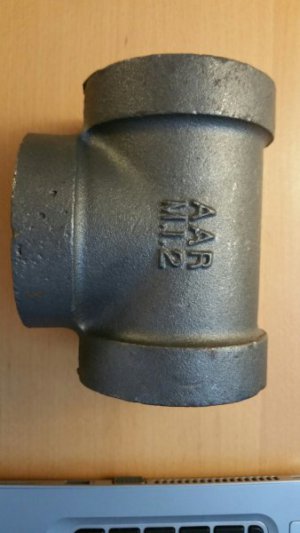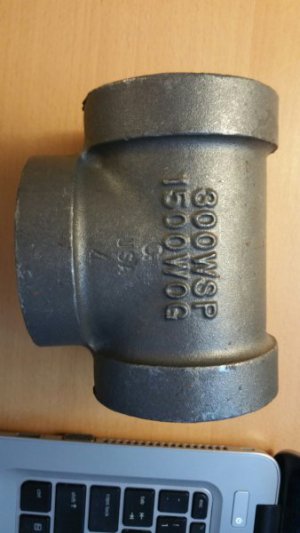I need to turn a pipe fitting on the lathe and wondering what speed to use and whether to use HSS or carbide. Here is a pic of what I am working with. What is this really made of? Appears to be cast iron??
-
Welcome back Guest! Did you know you can mentor other members here at H-M? If not, please check out our Relaunch of Hobby Machinist Mentoring Program!
You are using an out of date browser. It may not display this or other websites correctly.
You should upgrade or use an alternative browser.
You should upgrade or use an alternative browser.
Turning "black iron" (?) pipe
- Thread starter DiscoDan
- Start date
- Joined
- Mar 15, 2019
- Messages
- 708
I have turned several pipe fittings in just the past few days and it cuts and finishes very well. Very little monkeying with speed, feed or depth of cut to get a smooth finish.
- Joined
- Feb 13, 2017
- Messages
- 2,138
"Black iron", high carbon iron, hasn't been used for pipe for many, many years. What today is called "black iron" is basically cast steel that has not been galvanized. It seems (natural) gas reacts with the zinc in galvanizing and zinc is poisonous when heated, creating deadly fumes. Most plumbing codes, when dealing with gas piping, specify this black "iron".
I worked in a "foundry" during the '70s, a pipe shop. Making pipe from 4 inch to 13 inch. Larger pipe was made in a seperate plant, as was smaller pipe. There are still a few pipe shops operating here. (Birmingham) The pipe is classed as cast iron, but chemically is about the same as cast steel.
It can be welded to, and on. But must be treated ahead of time. And must be cut with a tool that scribes. But cannot be cut with a flame, it must be broken. But it can be bent into a horse shoe shape, under pressure. The QC machine for that is scarey
I worked in a "foundry" during the '70s, a pipe shop. Making pipe from 4 inch to 13 inch. Larger pipe was made in a seperate plant, as was smaller pipe. There are still a few pipe shops operating here. (Birmingham) The pipe is classed as cast iron, but chemically is about the same as cast steel.
It can be welded to, and on. But must be treated ahead of time. And must be cut with a tool that scribes. But cannot be cut with a flame, it must be broken. But it can be bent into a horse shoe shape, under pressure. The QC machine for that is scarey
- Joined
- Jun 7, 2013
- Messages
- 10,412
Sounds like you are talking about ductile iron, comes in many formulations with vastly different physical characteristics. Malleable iron has mostly been supplanted by ductile iron, it does not require the same lengthly annealing heat treatment that white cast iron requires, and indeed machines very nicely; most crankshafts these days are made of ductile, I used it for the crankshafts of the marine compound steam engines that I made years ago.
Are you making a milling head? I made one with a heavy duty 2" T fitting, worked great. Looks like the same thing you have there, very easy to machine with HSS.
Yes, that is exactly what I am attempting based on the YouTube video by BillT. I would be interested in seeing the one you built. Mine us for a small P&W 3C horizontal mill. Did you make your own spindle assembly? What taper did you make it?
Spindle assembly from 25mm od roller bearings with 25mm od shaft ER32 collect chuck from eBay. Wasn't aware of a YouTube video, that may have shortened my process. I've since taken it apart as I got a mill for a great deal. I'm going to repurpose the bearings and knee base I built in a diy surface grinder as I can't find one small enough to fit on my balcony workshop.








